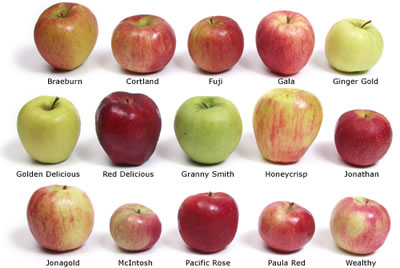The Great Red Delicious Bailout of 2000
The term “government bailout” emerged in the collective consciousness in 2008, when the U.S. government threw gobs of money at big banks, insurance companies, and the automotive industry, all in hopes of propping up businesses. The term “too big to fail” was a part of that conversation — many economists and politicians believed that if major companies in those sectors were to go under, the general economy would fall down the sinkhole after them. But bailouts aren’t a new thing. For example, in 2000, the government sent $30,000 to any orchardist who, for at least two of the three years prior, grew apples.
Why? Because the apples looked too good to be true.

As discussed previously in these pages (see here and here), apples come in a number of different varieties, known as cultivars. The most common cultivar in the U.S. is the Red Delicious, pictured above, constituting roughly a quarter to a third of all apples grown there. As seen below (via a website called SmoothieWeb), the Red Delicious is larger and redder than most other apples, which is a large part of the reason it is so popular. It’s the iconic stand-in for the entire set of varieties, and it’s probably what you envision when you picture an apple in your mind’s eye. It’s the apple that schoolchildren bring to their teacher in the fictionalized world where kids do such things.

It looks great and it tasted good, too — or did, until buyers for major supermarkets got involved.
At some point in the 1950s or so, someone realized that consumers can’t really judge apples by their taste, at least not on the individual apple level. Instead, we fruit buyers have to use other clues to figure out which piece to purchase and which pieces to pass on by. Size, color, and firmness are all readily detectable while still in the grocery store. Now, imagine an apple that is larger than the rest, has a deep red color, and has thick skin. That sounds like an apple that consumers would gladly purchase by the dozen — and those are exactly the criteria supermarket buyers focused on when grading orchardists’ apples. As a result, orchardists made sure that their Red Delicious apples grew to those standards.
Unfortunately, Red Delicious apples don’t taste that good when at that stage. Their skins have a lot of antioxidants, as the Washington Post notes, but as the skins get thicker, they also “tend to taste bitter to many palates.” The apples have an inconsistent taste profile and, perhaps worse, often have an overly soft texture. As one orchardist told the New York Times in 2000, “for almost 50 years, we’ve been cramming down the consumer’s throat a red apple with ever thicker skin, sometimes mushy, sometimes very good if done right, but a product that was bred for color and size and not for taste.” The apples look great but consumers weren’t happy with the taste.
That’s where the law of supply and demand kicked in. The amount of Red Delicious apples available was still enormous — in Washington state, for example, roughly 75% of all apples grown in the 1980s were of that variety. And given that Washington grows roughly two-thirds of America’s apples, that meant there were a lot of Red Delicious to be purchased. Consumers didn’t want the apples, though, and prices plummeted. Orchards were losing hundreds of millions of dollars a year, and in October of 2000, the federal government stepped in. Orchardists were given $30,000 to get them back on their feet; in total, the government spent $138 million in the bailout.
Red Delicious are still the most commonly grown apples in the U.S., although now only comprise about a third of the total annual apple yield. Orchardists have also taken to growing smaller, less-red, but tastier fruit. So in some sense, the bailout worked.
Bonus Fact: You can make a faux apple pie without apples. Here’s how.
From the Archives: Bad Apple: It’s not an apple — but it looks like one.
Take the Quiz: Where do apples come from?
Related: Your very own Red Delicious apple tree.
